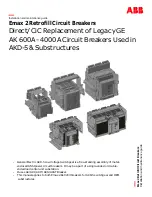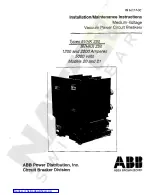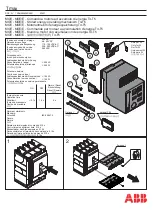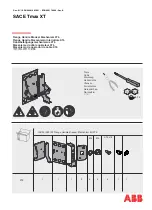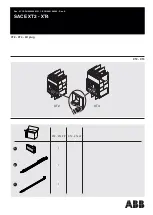
Contents
Precautions for Safety Use of the Instrument
1. Instrument Layout
2. Measurement
2.1 Preparation
for
Measurement
2.2 AC Current Measurement
2.3 How to Use Frequency Selector Button
2.4 Peak Current Measurement
3. Other Functions
3.1 Auto-Power-Off
Function
3.2 Data Hold Function
3.3 Optional
Accessories
4. Battery Replacement
5. Specifications
6. Calibration and After-sales Service
Precautions for Safe Use of the Instrument
When handling the instrument, ALWAYS observe all of the cautionary
notes on safety given below. Yokogawa M&C Corporation is not at all
liable for damage resulting from misuse of this product by the user
that is contrary to these cautionary notes.
Various symbols are used on the instrument and in this manual to
ensure the product is used safety and to protect operators and
property from possible hazards or damage. The following safety
symbols are used where appropriate. Read the explanations carefully
and familiarize yourself with the symbols before reading the text.
The instrument and this manual use the following safety symbols:
Danger! Handle with Care.
This symbol indicates that the operator must refer to an
explanation in the User’s Manual in order to avoid the risk
of personal injury or death and/or damage to the
instrument.
Double Insulation
This symbol indicates double insulation.
AC Voltage/Current
This symbol indicates AC voltage or current.
Ground
This symbol indicates ground (earth)
WARNING
Indicates that there is a possibility of serious personal injury or loss of
life if the operating procedure is not followed correctly and describes
the precautions for avoiding such injury or loss of life.
CAUTION
Indicates that there is a possibility of serious personal injury of
damage to the instrument if the operating procedure is not followed
correctly and describes the precautions for avoiding such injury or
damage.
NOTE
Draws attention to information essential for understanding the
operation and features.
WARNING
●
Never make measurement on a circuit above 300V AC.
●
Do not use the instrument in an atmosphere where any flammable
or explosive gas is present.
●
Do not attempt to make measurement in the presence of
flammable gasses, fumes, vapor or dust. Otherwise, the use of the
instrument may cause sparking, which can lead to an explosion.
●
Avoid using the instrument if it has been exposed to rain or
moisture or if your hands are wet.
●
Do not exceed the maximum allowabIe input of any measurement
range.
●
Never open the battery compartment cover when making
measurement.
●
Do not use the instrument if there is any damage to the casing or
when the casing is removed.
●
Do not install substitute parts or make any modification to the
instrument. Return the instrument to Yokogawa M&C or your
distributor for repair or re-calibration.
●
Always switch off the instrument before opening the battery
compartment cover for battery replacement.
WARNING
To avoid damage to the instrument or electric shock!
The restrictions on the maximum voltage level for which the CL340
testers can be used, depend on the over-voltage categories specified
by the safety standards. These category specifications are formulated
to protect operators against transient impulse voltage in power lines.
Maximum Allowable Input
Function
OVERVOLTAGE CATEGORY III
A
400Arms AC
Measuring circuit voltage : 300Vrms AC
Over-voltage category I (CAT.I):
Signal level, special equipment or parts of equipment, telecommunication,
electronic etc., with smaller transient over-voltages than CAT.II.
Over-voltage category II (CAT.II)
Local level, appliance, portable equipment etc., with smaller transient
over-voltages than CAT.III.
Over-voltage category III (CAT.III):
Distribution level, fixed installation, with smaller transient over-voltages than
CAT.IV.
CAUTION
●
Be sure to set the Range switch to the "OFF" position after use.
When the instrument will not be in use for a long period of time,
Place it in storage after removing the battery.
●
Use a damp cloth and detergent for cleaning the instrument. Do not
use abrasives or solvents.
NOTE
●
Radiation immunity affects the accuracy of CL340 testers under the
conditions specified in EN 61000-4-3:1997.
●
If equipment generating strong electromagnetic interference is
located nearly, the testers may malfunction.
1. Instrument Layout
Range Selector Switch
Open/Close Lever
Transformer Jaws
Data Hold Button
Peak Hold Button
Display
Data Hold Indication
Low Battery Warning
Frequency
Response
[WIDE]
Frequency
Response
[50/60Hz]
Unit of measured
quantity
LCD
Hand Strap
Peak Hold Indication
Frequency Selector Button
2. Measurement
2.1 Preparation
for
Measurement
WARNING
●
Do not make measurement on a circuit above 300V AC. This may
cause shock hazard or damage to the instrument or equipment
under test.
●
When measuring current is 300A or more (400Hz or more), be sure
to stop measurement within 5 minutes. Otherwise, transformer
jaws may heat to cause a fire or deformation of molded parts,
which will degrade insulation.
CAUTION
●
The jaw section is a delicate, precision sensor. Do not subject the
jaw to unreasonably strong shock, vibration, or force when using it.
●
If dust gets into the tops of the jaws, remove it immediately. Do not
close the jaws when dust is trapped in its joints as the sensor may
break.
●
Please check that the Range switch is set to the desired position
before measurement.
NOTE
●
During current measurement, keep the transformer jaws fully
closed. Otherwise, accurate measurement cannot be made. The
maximum measurable conductor size is approx. 40mm in diameter.
●
When measuring large current, the transformer jaws may buzz.
This has no effect on the instrument’s performance or safety.
2.2 AC Current Measurement
(1) Set the Range switch to the desired position. Current to measure
should be within the selected measuring range.
(2) Normal measurement : (See figure below)
Press the open/close lever to open the transformer jaws and
close them over one conductor only. Measured current value is
shown on the display. Earth leakage current or small current that
flows through a grounded wire can also be measured by this
method.
Lo
a
d
Correct
Wrong
Lo
a
d
(3) Measuring out of balance leakage current : (See figure below)
Clamp onto all conductors except a grounded wire. Measured
current value is shown on the display.
Lo
a
d
Note : In case of 3-phase 3-wire,
clamp four wires for measurement.
3-phase 3-wire
1-phase 2-wire
Lo
a
d
Note : In case of 1-phase 3-wire,
clamp three wires for measurement.
2.3 How to Use Frequency Selector Button
When high frequencies from such equipment as inverters are present
in the circuit under test, the instrument measures AC current of not
only 50Hz or 60Hz of fundamental frequency but also of these high
frequencies and harmonics.
To eliminate the effect of such high frequency noise and measure AC
current of 50Hz or 60Hz fundamental frequency, a "high-cut" filter
circuit in incorporated into the instrument which works when
"50/60Hz" frequency response is selected with the Frequency
Selector button. Cut-off frequency of "high-cut" filter is about 160Hz
with attenuation characteristic of approx. -24dB/octave.
NOTE
Characteristic of -24dB/octiave means that signal magnitude declines
to about one sixteenth of that at the initial frequency when frequency
doubles.
The Frequency Selector button has the following two positions.
●
WIDE (20Hz or more) :
Permits measurement of currents of fundamental frequencies as
well as currents of high frequencies generated by such equipment
as inverters.
●
50/60Hz (20 to approx. 160Hz) :
Filters out high frequency currents and measures current of
fundamental frequency only.
When the
button is pressed, "
" mark is shown on the left
side of the display. When the
button is pressed again,
frequency response is switched to WIDE with "
" mark shown on
the display.
Frequency
Per
ce
n
ta
ge
A
ttenu
ation
Frequency Characteristic
(dB)
(Hz)
Typical characteristic :
4/40/400mA
Typical characteristic :
100/400A
Typical characteristic :
”WIDE” frequency response
Typical characteristic :
"50/60Hz" frequency response
high-cut filter -24dB/oct
Recently there has been increased use of power through inverters,
switching regulators, etc. When the high frequency noise from such
appliances leaks or flows into the ground through capacitors not
filtering completely, the earth leakage breaker may trip even though
there is no "actual" leakage. In such a case, the instrument do not
give leakage current reading if "50/60Hz" frequency response is
selected.
Take care readings with the 50/60Hz and WIDE frequency responses
respectively to make effective use of the Frequency Selector button.
2.4 Peak
Current
Measurement
(1) Set the Range switch to the desired position. (Current to measure
should not exceed the selected measuring range.)
(2) Select "
" or "
" within the
button.
(3) With the transformer jaws clamped onto the conductor under test,
press the
button to set the interment to the peak
measurement mode. (."
" is shown on the display.)
(4) The display read 1/
2
of the peak current value. Therefore an rms
reading is shown when current of a sinusoidal waveform is measured.
(5) After peak measurement, press the
button to return to the
normal measurement mode.
NOTE
When leakage current is measured in the peak measurement mode,
the reading may change if the transformer jaws are opened and
closed. Please read the display with the conductor under test clamped,
otherwise, after fixing the display by using the data hold function,
please remove the instrument from the conductor to be measured,
and read the display. To measure the peak current again, please
release the data hold, and return the instrument to the normal
measurement mode once with the
button, then set it in the
peak measurement mode.
3. Other Functions
3.1 Auto-Power-Off
Function
This is a function to prevent the instrument from being left powered on
and conserve battery power. The instrument automatically turns off about
10 minutes after the last switch or button operation. To return to the
normal mode, turn the Range switch to OFF, then to the desired position.
Disabling Auto-Power-Off Function:
To disable the auto-power-off function, power on the instrument with
the Data Hold button pressed. About 3 seconds after powering on the
instrument, "P.OFF" is shown on the display. To enable the
auto-power-off function, turn on the instrument without pressing the
Data Hold button.
NOTE
The auto-power-off function is disabled in the peak measurement mode.
3.2 Data Hold Function
This is a function to freeze the reading on the display. When the
button is pressed once, the current reading is held even though
current under test varies. "
" mark is shown on the upper right
corner of the display.
To exit the data hold mode, press the
button again.
NOTE
When the auto-power-off function works while the instrument is in the
data hold mode, data hold is cancelled.
3.3 Optional
Accessories
Clamp Adapter Model 99025 (For AC current measurement only)
Clamp Adapter Model 99025 is designed to increase the measuring
capability of a clamp meter. With the use of the Clamp Adapter, you
can not only extend current range over 3000A, but also clamp on a
large bus-bar or conductor.
(1) Set the Range switch to the "
400A " position.
(2) As shown in the figure right, clamp Model CL340
onto the pickup coil of Model 99025.
(3) Clamp Model 99025 onto the bus-bar or
conductor under test.
(4) Take the reading on Model CL340 and multiply it
by 10.
NOTE
The clamp adapter is not applicable to leakage
current measurement.
For detailed specification, refer to the Clamp Adapter User’s Manual.
4. Battery Replacement
WARNING
To avoid electric shock hazard, never try to replace batteries during
measurement.
CAUTION
●
Do not mix new and old batteries.
●
Make sure to install battery in correct polarity as indicated in
battery compartment.
If the battery voltage becomes too low for the instrument to operate
normally, "
" is shown on the display. Then, replace the battery.
Note that when the battery is completely exhausted, the display
blanks without "
" shown.
(1) Set the Range switch to the "OFF" position.
(2) Press in the hole on the battery compartment cover with the tip of
a pointed object, then slide open the cover.
(3) Replace the battery observing correct polarity. Use two new R03
(UM-4) 1.5V batteries.
(4) Slide the battery compartment cover back in place.
NOTE
For use for a log period of time,
use alkaline batteries.
5. Specifications
Instrument Specifications
Measuring Ranges and Accuracy (at 23 ±5°C, relative humidity up to 85%)
AC Current
Conversion method : AC coupled, true rms responding, calibrated to the rms
Ranges Measuring
range
Frequency response
Accuracy (frequency range)
WIDE
±
1.0% rdg
±
5dgt (50/60Hz)
±
2.5% rdg
±
10dgt (20
~
1kHz)
40mA 0
~
41.99mA
50/60Hz
±
1.0% rdg
±
5dgt (50/60Hz)
WIDE
±
1.0% rdg
±
5dgt (50/60Hz)
±
2.5% rdg
±
10dgt (20
~
1kHz)
400mA 0
~
419.9mA
50/60Hz
±
1.0% rdg
±
5dgt (50/60Hz)
WIDE
±
1.0% rdg
±
5dgt (50/60Hz)
±
2.5% rdg
±
10dgt (20
~
1kHz)
0
~
100.0A
50/60Hz
±
1.0% rdg
±
5dgt (50/60Hz)
WIDE
±
1.0% rdg
±
5dgt (50/60Hz)
±
2.5% rdg
±
10dgt (40
~
1kHz)
100.1
~
300.0A
50/60Hz
±
1.0% rdg
±
5dgt (50/60Hz)
WIDE
±
2.0% rdg (50/60Hz)
±
5.0% rdg (40
~
1kHz)
400A
300.1
~
419.9A
50/60Hz
±
2.0% rdg (50/60Hz)
Peak Current (10ms)
Ranges Measuring
range
Frequency response
Accuracy (frequency range)
WIDE
±
1.2% rdg
±
6dgt (50/60Hz)
±
3.0% rdg
±
11dgt (20
~
1kHz)
40mA 0
~
41.99mA
50/60Hz
±
1.2% rdg
±
6dgt (50/60Hz)
WIDE
±
1.2% rdg
±
6dgt (50/60Hz)
±
3.0% rdg
±
11dgt (20
~
1kHz)
400mA 0
~
419.9mA
50/60Hz
±
1.2% rdg
±
6dgt (50/60Hz)
WIDE
±
1.0% rdg
±
6dgt (50/60Hz)
±
3.0% rdg
±
11dgt (20
~
1kHz)
0
~
100.0A
50/60Hz
±
1.2% rdg
±
6dgt (50/60Hz)
WIDE
±
1.2% rdg
±
6dgt (50/60Hz)
±
3.0% rdg
±
11dgt (40
~
1kHz)
100.1
~
300.0A
50/60Hz
±
1.2% rdg
±
6dgt (50/60Hz)
WIDE
±
2.4% rdg (50/60Hz)
±
6.0% rdg (40
~
1kHz)
400A
300.1
~
419.9A
50/60Hz
±
2.4% rdg (50/60Hz)
When measuring current which pulse element is superposed, differences of the
indicated value may be caused between ranges, if the peak value exceeds the
measurement range to a large extent. In this case, the reading at the bigger range
should be taken as a right value.
General Specifications
●
Operating System : Sequential comparison
●
Measurement Function : AC current
●
Display : Liquid crystal display with maximum counts of 4200
●
Overrange Indication : "OL" is shown on the display
●
Response Time : Approx. 2 seconds.
●
Sample Rate : Approx. 2.5 times per seconds.
●
Temperature and Humidity for Guaranteed Accuracy : 23°C ±5°C, relative
humidity 85% without condensation
●
Operating Temperature and Humidity : 0 to 40°C, relative humidity up to 85%
without condensation
●
Storage Temperature and Humidity : -20 to 60°C, relative humidity up to 85%
without condensation
●
Effect of conductor position :
40/400 mA range : Within
±
5 dgt at every part inside the jaws
400 A range, 0 to 250 A : Within
±
0.5% rdg,
±
5 dgt, at every part inside the jaws
251 to 300 A : Within
±
4.0% rdg,
±
5 dgt, at every part inside the jaws
301 to 400 A : Within
±
7.0% rdg,
±
5 dgt, at every part inside the jaws
●
Effect of external magnetic field : 10 mA or less in proximity to a 15 mm-dia
conductor carrying 100 A
●
Effect of residual current : 12 mA or less when clamping on two 10 mm-dia
conductors, each carrying supply or return 100 A AC current
●
Power Source : Two R03 (UM-4) 1.5V batteries
●
Battery Life : Approx. 24 hours (continuous)
●
Current Consumption : Approx. 21mA
●
Auto-power-off function : Turns power off approx. 10 minutes after the last
switch operation
●
Withstanding Voltage : 3700V AC, 50/60Hz for 1 minute between electrical
circuit and housing case or metal part of the jaws
●
Insulation Resistance : 50M
Ω
or greater at 1000V between electrical circuit and
housing case or metal part of the jaws
●
Conductor Size : Approx. 40mm diameter max.
●
Dimensions : Approx. 81(W) x 185(H) x 40(D) mm
●
Weight : Approx. 270g
●
Safety Standard: EN 61010-1
EN
61010-2-032
(300V AC CAT III, Pollution degree2, indoor use)
●
EMC Standard : EN 61326
EN
55022
●
Accessories : R03 batteries ········································· 2
Carrying case Model 93030··················· 1
User’s
Manual········································ 1
●
Optional Accessories : Clamp adapter Model 99025
6. Calibration and After-sales Service
Should any failure occur while you are using the tester, follow the
instructions given below. If the tester still fails to operate correctly and
needs repair, contact the vendor from whom you purchased the
instrument or the nearest Yokogawa M&C sales office.
●
Turn off the POWER switch once, then turn it back on again.
●
If the tester does not turn on, replace the battery with a new one.
Calibration
It is recommended that the instrument be calibrated once every year.
YOKOGAWA M&C CORPORATION
International Sales Dept.
2-9-32 Nakacho, Musashino-shi, Tokyo, 180-8750 Japan
Phone: 81-422-52-5716 Facsimile: 81-422-55-8654
YOKOGAWA CORPORATION OF AMERICA (U.S.A.)
Phone: 1-770-253-7000 Facsimile: 1-770-251-2088
YOKOGAWA EUROPE B. V. (THE NETHERLANDS)
Phone: 31-334-64-1611 Facsimile: 31-334-64-1610
YOKOGAWA AMERICA DO SUL S. A. (BRAZIL)
Phone: 55-11-5681-2400 Facsimile: 55-11-5681-1274
YOKOGAWA ENGINEERING INSTRUMENTS KOREA CORPORATION (KOREA)
Phone: 82-2-551-0660 to -0664 Facsimile: 82-2-551-0665
YOKOGAWA AUSTRALIA PTY. LTD. (AUSTRALIA)
Phone: 61-2-9805-0699 Facsimile: 61-2-9888-1844
YOKOGAWA BLUE STAR LTD. (INDIA)
Phone: 91-80-227-1513 Facsimile: 91-80-227-4270
LTD. YOKOGAWA ELECTRIC (RUSSIAN FEDERATION)
Phone: 7-095-737-7868 Facsimile: 7-095-737-7869
KIM3E-2003.2
User’s
Manual
CL345
Leakage Clamp-on Tester
IM CL345
1st Edition: July 2003 (MC)
IM CL345
Battery
Compartment Cover
Screw
Batteries


